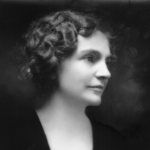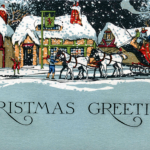Robert Spear Dunning’s 1885 oil-on-panel landscape painting, Autumn at Medway, acquired by the FRHS in April, 2018, has returned from the conservator restored to its former brilliance – and a little gem of a piece it is. Fortunately the conservation treatment required nothing more than removing a heavy layer of built-up surface grime and old varnish; no inpainting necessary.
Dunning packed a great deal into a diminutive 4.5 x 8.5 inch panel, and the intimate scene that emerged from the grime – a couple punting on the Charles River near the Shaw Street Bridge in Medway – is absolutely lovely. It exhibits the artist’s masterful handling of the myriad, gem-like colors of a New England autumn and serves to document his expertise as a landscape artist. Still, Dunning’s work in this oeuvre is overshadowed by the still life compositions for which he is justly famed, and I think they are grossly underappreciated.
The research to document the provenance of Autumn at Medway is beginning to bear fruit, and we now know more about its history. Its sale history, to be precise.
Why is provenance important?
Because it provides a history of ownership and exhibition, and can help confirm the authenticity of an object. That history may include a chain of private individuals, various auction houses, galleries and/or dealers, museums, or other institutions. But when researching provenance, caution is paramount: history must be supported with documentation, such as invoices, photographs, exhibition records, and the like. It is important to remember that while oral history and family lore is interesting – and often based in some fact – it tends to be exaggerated over time.
As with most things, when exploring provenance it is most logical to start with the most recent events; in this case, the auction house that last sold the painting. One must bear in mind, however, that an auction house is duty bound to protect the identity of its consignors – mum’s the word – but when a museum is concerned, some firms are willing to forward a message to the consignor, or to inquire personally, which can be extremely helpful.
In this case, John Fontaine of Fontaine’s Auction Gallery – the house that handled the last sale of the painting – was extremely accommodating, and at my request did, indeed, contact the consigner to ascertain any history of the piece as they knew it.
The response: The consignor had “little knowledge of its history or provenance. He bought it from an estate sale,” but, unfortunately, did not recall – or was not willing to reveal – the particulars.
Not much to go on, alas … but something.
So, the quest began, utilizing internet searches, scanning auction listings, and inquiring via email and telephone. Luckily, bit by bit, we have been able to forge a chain of provenance: Three links and counting.
Here is what we know thus far:
April 21, 2018: The painting was offered for sale by Fontaine’s Auction Gallery, Pittsfield, Massachusetts, as Lot #2, in their Fine Art Auction; it was acquired for the FRHS collection.
August 31, 2017: The painting was offered for sale by Central Mass Auctions, Inc., Worcester, Massachusetts, in their Antique Estates Auction.
June 10, 2017:The painting was brought to a Treasure’s In the Attic appraisal day, sponsored by the Townsend Historical Society in Townsend, Massachusetts. The appraiser in charge of the event was associated with Central Mass Auctions, Inc., and the painting was subsequently consigned to their August 31, 2017 sale.
The next step: Attempting to ascertain the identity of the individual who brought the painting to the Townsend Historical Society event for evaluation in June, 2017. Inquiries have been made and I am hoping for a response.
Based on the fact that the painting had survived in its original, unrestored condition, for well over a century leads me to believe that it most likely remained in a private collection – possibly that of the person who brought it to the Treasures in the Attic appraisal day – for considerable time. Identifying that individual may help to document the history of the piece prior to its being offered at auction.
If Fortuna is feeling benevolent, perhaps we may be able to trace its history directly to the artist.
Fingers crossed!









